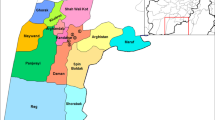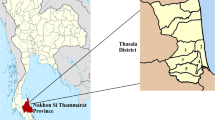Abstract
Giardiasis and soil-transmitted helminthiasis (STH) are parasitic diseases that are among the major health concerns observed in economically disadvantaged populations of developing countries, and have clear social and environmental bases. In Brazil, there is a lack of epidemiologic data concerning these infections in the study area, whose inhabitants have plenty of access to health care services, including good dwelling and adequate sanitary conditions. In this survey we investigated the risk factors for giardiasis and STH in three municipalities with good sanitation, situated in Minas Gerais state, Brazil. A cross-sectional survey was conducted in the municipalities of Piau, Coronel Pacheco and Goianá, in both urban and rural areas. The fieldwork consisted of a questionnaire and the examination of 2,367 stool samples using the Hoffmann, Pons and Janer method. Of all individuals from the population sample, 6.1% were found infected with the parasitic diseases included in this work. Hookworm infection was the most prevalent disease, followed by giardiasis, trichuriasis and ascariasis. Infection was more prevalent in males (8.1%, p < 0.001; odds ratio [OR] = 1.975) and in individuals living in rural areas (8.6%, p = 0.003; OR = 1.693). Multivariate analysis showed that variables such as inadequate sewage discharge (p < 0.001), drinking of unsafe water (p < 0.001), lack of sanitary infrastructure (p = 0.015), and host sex (p < 0.001) were the risk factors more strongly associated with infection status (95% confidence interval [CI]). In this study we demonstrate that giardiasis and STH still persist, infecting people who have good housing conditions and free access to public health care and education.

Similar content being viewed by others
References
Albonico M, Allen H, Chitsulo L, Engels D, Gabrielli A-F, Savioli L (2008) Controlling soil-transmitted helminthiasis in pre-school-age children through preventive chemotherapy. PLoS Negl Trop Dis 2:e126
Brasil (2004) Ministério da Saúde—Sistema de Informação da Atenção Básica, siab.datasus.gov.br/. Accessed June 24, 2009
Brasil (2009) Ministério da Saúde, Secretaria de Epidemiologia e Vigilância da Saúde www.ripsa.org.br/. Accessed June 12, 2009
Brooker S, Clements ACA, Bundy DAP (2006) Global epidemiology, ecology and control of soil-transmitted helminth infections. Adv Parasitol 62:221–261
Bugg RJ, Robertson ID, Elliot AD, Thompson RCA (1999) Gastrointestinal parasites of urban dogs in Perth, Western Australia. Vet J 157:295–301
Campos MR, Valencia LIO, Fortes BDPMD, Braga RCC, Medronho RDA (2002) Distribuição espacial da infecção por Ascaris lumbricoides. Rev Saúde Pública 36:69–74
Costa-Macedo LM, Costa MCE, Almeida LM (1999) Ascaris lumbricoides in infants: a population-based study in Rio de Janeiro, Brazil. Cad Saúde Pública 15:173–178
De Silva N, Brooker S, Hotez P, Montresor A, Engels D, Savioli L (2003) Soil-Transmitted Helminthic Infections: Updating the Global Picture. Working Paper No. 12
Drake LJ, Jukes MCH, Sternberg RJ, Bundy DAP (2000) Geohelminth infections (ascariasis, trichuriasis, and hookworm): cognitive and developmental impacts. Semin Pediatr Infect Dis 11:245–251
Franzén O, Jerlström-Hultqvist J, Castro E, Sherwood E, Ankarklev J, Reiner DS, Palm D, Andersson JO, Andersson B, Svärd SG (2009) Draft genome sequencing of Giardia intestinalis assemblage B isolate GS: is human giardiasis caused by two different species? PLoS Pathog 5:e1000560. doi:10.1371/journal.ppat.1000560
Graczyk TK, Grimes BH, Knight R, Silva AJ, Pieniazek NJ, Veal DA (2003) Detection of Cryptosporidium parvum and Giardia lamblia carried by synanthropic flies by combined fluorescent in situ hybridization and a monoclonal antibody. Am J Trop Med Hyg 68:228–232
Hoffmann WA, Pons JA, Janer JL (1934) The sedimentation-concentration method in schistossomiasis mansoni. The Puert Rico J Publ Health Trop Med 9:283–298
Hotez PJ (2008) The giant anteater in the room: Brazil’s neglected tropical diseases problem. PLoS Negl Trop Dis 2:e177
Hotez PJ, De Silva N, Brooker S, Bethony J (2003) Soil transmitted helminth infections: the nature, causes and burden of the condition. Disease Control Priorities Project. DCPP Working Paper No.3. http://www.dcp2.org/file/19/wp3.pdf
IBGE (2000) Instituto Brasileiro de Geografia e Estatística http://www.ibge.gov.br/home/estatistica/populacao/default_censo_2000.shtm. Accessed May 10, 2009
IBGE (2005) http://www.comiteps.sp.gov.br/a_bacia.html. Accessed Nov. 05, 2009.
Jardim-Botelho A, Raff S, Hoffman RRA, HJ DDJ, Corrêa-Oliveira R, Bethony JM, Gazzinelli MF (2008) Hookworm, Ascaris lumbricoides infection and polyparasitism associated with poor cognitive performance in Brazilian schoolchildren. Trop Med Int Health 13:994–1004
Kagei H (1983) Techniques for the measurement of environmental pollution by infective stages of soil transmitted helminthes. In: Yokogawa M, Hayashi S, Kobayashi A, Kagei H, Suzuki N, Kunni C (eds) Collected papers on the control of soil-transmitted helminthiasis. Asian Parasite Control Organization, Tokyo, pp 27–46
Lane S, Lloyd D (2002) Current trends in research into the waterborne parasite Giardia. Crit Rev Microbiol 28:123–147
Macpherson CNL (2005) Human behavior and the epidemiology of parasitic zoonoses. Int J Parasitol 35:1319–1331
Muniz PT, Castro TG, Araújo TS, Nunes NB, da Silva-Nunes M, Hoffmann EH, Ferreira MU, Cardoso MA (2007) Child health and nutrition in the Western Brazilian Amazon: population-based surveys in two counties in Acre State. Cad Saúde Pública 23:1283–1293
Murta FL, Massara CL (2008) Presença de ovos de helmintos intestinais em ônibus de transporte público em Belo Horizonte–Minas Gerais, Brasil. Rev Patol Trop 38:207–212
Robertson ID, Irwin PJ, Lymbery AJ, Thompson RCA (2000) The role of companion animals in the emergence of parasitic zoonoses. Int J Parasitol 30:1369–1377
Savioli L, Smith H, Thompson A (2006) Giardia and Cryptosporidium join the ‘Neglected Diseases Initiative’. Trends Parasitol 22:203–208
Smith HM, DeKaminsky RG, Niwas S, Soto RJ, Jolly PE (2001) Prevalence and intensity of infections of Ascaris lumbricoides and Trichuris trichiura and associated socio-demographic variables in four rural Honduran communities. Mem Inst Oswaldo Cruz 96:303–314
Sprong H, Cacció SM, Giessen JWBVD (2009) Identification of zoonotic genotypes of Giardia duodenalis. PLoS Negl Trop Dis 3:e558
Thompson RCA (2004) The zoonotic significance and molecular epidemiology of Giardia and giardiasis. Vet Parasitol 126:15–35
Traub RJ, Monis PT, Robertson I, Irwin P, Mencke N, Thompson RCA (2004) Epidemiological and molecular evidence supports the zoonotic transmission of Giardia among humans and dogs living in the same community. Parasitology 128:253–262
Traub RJ, Robertson ID, Irwin PJ, Mencke N, Thompson RCA (2005) Canine gastrointestinal parasitic zoonoses in India. Trends Parasitol 21:42–48
United Nations Development Program UNDP (2000) http://www.pnud.org.br/. Accessed June 24, 2009
Volotão AC, Costa-Macedo LM, Haddad FSM, Brandão A, Peralta JM, Fernandes O (2007) Genotyping of Giardia duodenalis from human and animal samples from Brazil using [beta]-giardin gene: a phylogenetic analysis. Acta Trop 102:10–19
Acknowledgements
This work was supported by FAPEMIG. We acknowledge Dr. José Laerte da Silva Barbosa, Dr. Eunice Caldas de Figueiredo Dantas, and Lourdes Maria Tasca Tavares (GRS/JF) for permission and support in the conduction of this research; we also give special thanks to Vera de Deus Pereira, for helping with the SPSS program, to the municipal authorities, to the fieldworkers, and to the people of Piau, Coronel Pacheco, and Goianá for their essential cooperation with the research.
Author information
Authors and Affiliations
Corresponding author
Rights and permissions
About this article
Cite this article
Pinheiro, I.d.O., de Castro, M.F., Mitterofhe, A. et al. Prevalence and risk factors for giardiasis and soil-transmitted helminthiasis in three municipalities of Southeastern Minas Gerais State, Brazil. Parasitol Res 108, 1123–1130 (2011). https://doi.org/10.1007/s00436-010-2154-x
Received:
Accepted:
Published:
Issue Date:
DOI: https://doi.org/10.1007/s00436-010-2154-x




